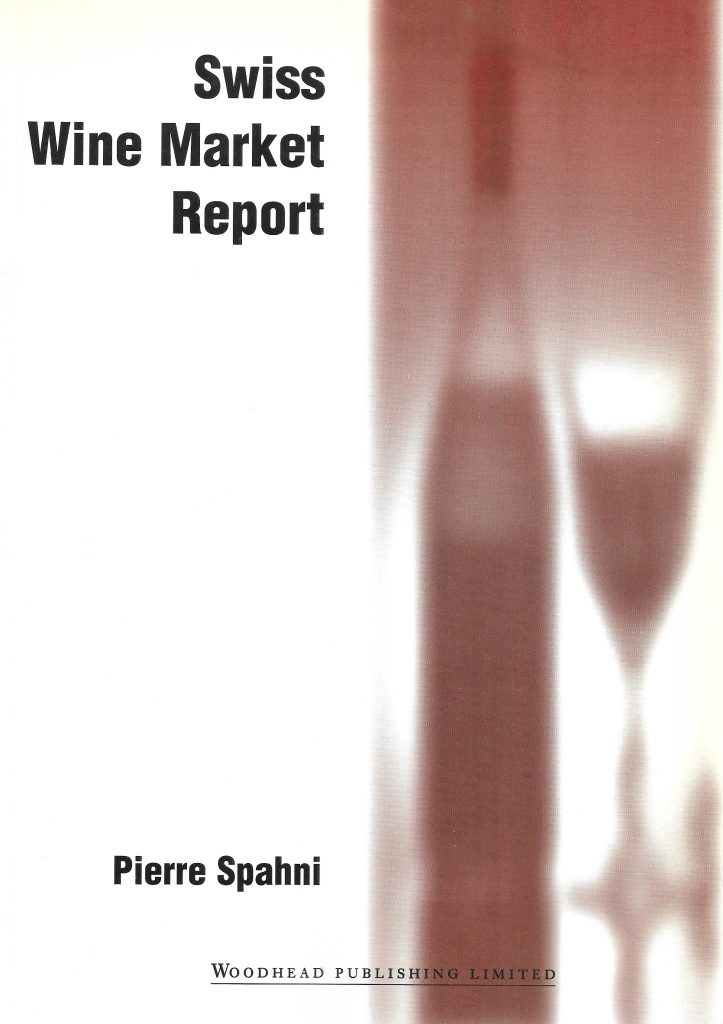SWISS WINE MARKET REPORT
Pierre Spahni, Woodhead Publishing Ltd, Cambridge UK
1988, 192 pages A4, ISBN 978-1-8456-9915-4 (e-book)

***
A key tool for anyone attempting to gain access to the lucrative Swiss market.
The report can be obtained in various forms directly from the publisher (now part of Elsevier).
***
Abbreviations
Introduction
Executive summary
1. Political situation and economic outlook
Political stability
Economic stagnation
2. Trends in wine consumption
Post-war trends
Two markets out of phase
Consumption and purchasing patterns
3. The market for reds
Domestic wines
Imported wines
4. The market for whites
Domestic wines
Imported wines
5. Retail channels
Channels supplying consumption in public (‘on-trade’)
Retailing channels for home consumption (‘off-trade’)
6. Wholesalers and negociants
Food wholesalers, C&Cs and buying centres/co-operatives
Negociants
7. Marketing and trade policy changes
The new legislation on food marketing
A much freer import regime
Perspectives
Appendices
Import data
Top 100 contacts
Index
The Swiss wine industry is waking up to a new challenge: to raise the competitiveness of its wines, which has been eroded by the general strength of the country’s currency during the first half of the 1990s and is becoming ever more evident as the liberalisation of the country’s trade regime is taking hold.
The problem may not be as acute for red wines – which have had to endure a good deal of exposure since the system of import quotas was overhauled in the early 1990s – as for whites which make up the backbone of domestic viticulture and still enjoy good protection at the country’s borders. Ground has been surrendered to foreigners already, at the cheap end of the market for whites, as the result of the replacement of quantitative restrictions with a system of tariffs in mid-1995. Medium-priced wines will be next to come under pressure as tariff walls are lowered and the gate admitting limited quantities of wines at near-zero tariff rates (so-called ‘tariff quota’) is opened up progressively, then almost burst open in 2001.
The comfortable position secured by Switzerland’s traditional suppliers during decades of protectionism , through bilateral agreements, is also being undermined by the scrapping of all types of preferential clauses. Advantages due to proximity are starting to be outweighed in ever more frequent cases by growing consumer interest in exciting new wines produced overseas and by a sprawling network of retailers. But would a greater choice of more affordable wines succeed in reversing the fall in overall demand, which experienced a buck in trend in 1990 and has now settled, temporarily, at around 300 million litres, some 10% off its peak? Or was it just the perspective of climbing out of economic stagnation that helped to invigorate sales of late? Is demand really bottoming out or is this just a blip in a general downward trend?
Who else could stand to gain from present changes? Is the current rationalisation and internationalisation of distribution channels not doomed to have an impact on the origin and type of wines offered to Swiss customers, given their reluctance to join the EU? Supermarkets are marketing ever larger volumes of wines, thus warranting wine purchasing departments of their own, and they tend to distance themselves ever more from local producers, having to worry about margins instead. Temptation to bypass the domestic negociants must surely be facilitated by the increasing trend, by consumers, to purchase wines bottled in the region of production? Could integration not take place through the back-door – say through foreign acquisition of a food retail chain? Is the equally important hotel-restaurant-cafés (Horeca) sector immune to international forces or are there any distributors ready to fall prey to global drinks manufacturers?
This report brings together material aiming to assist readers in their quest for clues to these and other vital issues shaping the future of the Swiss wine market (many times cheaper than a proper market study, it would not claim to be a substitute for one). After a brief look at the country’s socio-economic situation (mostly intended for foreign readers), consumption patterns are reviewed in a second chapter . The market for reds and that for whites are then looked at separately in Chapters 3 and 4 respectively. Much of the emphasis is laid on imports, which have hardly been looked at to date (the section on imported whites is understandably much shorter than that for reds, for the reason that whites were subjected to a basic import interdiction over the past 60 years and allowed in only erratically, in order to compensate for poor domestic harvests and, hence, stabilise domestic prices as required by legislation). Detailed import statistics since the world-wide revision of tariff nomenclature in 1988, are featured in the first appendix. A look at distribution channels in Chapter 5 shows how wines reach final consumers: it sums up recent moves and helps sense future changes at firm level. The who’s who of negociants–importers is compiled in Chapter 6 and their details presented in the second appendix. The last chapter reviews the most recent policy changes and looks ahead at those planned until 2001 and beyond.
The report is intended for foreign readers primarily – not just exporters seeking to gain a better knowledge of this major wine import market but also for economists, lawyers and civil servants interested in the wine sector and those dealing with Swiss trade issues in general. English being a second language to most Swiss, this report is also intended for them: negociants, retailers, producers, trade associations and policy makers of all levels and creed alike.
March 1998
***